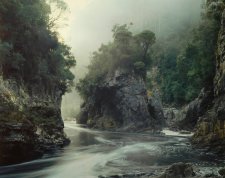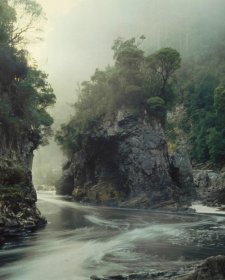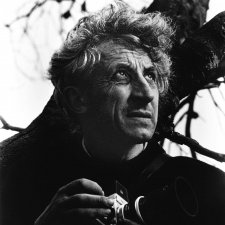Olegas Truchanas (1923-1972) was born in 1923 in Siauliai, Lithuania. At 18, fleeing the Russian invasion, he moved to Germany where he worked till the end of World War Two. He migrated to Australia in 1948, undertaking his two years of consigned labour at Electrolytic Zinc Company’s works on the Derwent River, Tasmania. During this time he explored the surrounding landscapes, saved for walking boots and a camera and joined the Tasmanian Miniature Camera Club. Among his notable undertakings were a solo climb of Federation Peak – an awesomely precipitous quartzite monolith at the south-eastern end of the Arthur Range – in 1952; and the first known journey down the Serpentine and Gordon Rivers from Lake Pedder to Strahan on the west coast – an epic solo paddle Truchanas accomplished in a kayak he designed and built himself. Colour photographs he took were later used in lectures to show the heritage significance of the South West to the Tasmanian people. As a volunteer National Fitness Camp instructor Truchanas taught wild water canoeing and photography to many including the young Peter Dombrovskis. In the early 1960s, when the Hydro Electric Commission and Premier 'Electric Eric' Reese controversially announced a plan to dam the rivers of South West Tasmania and flood Lake Pedder, Truchanas's images were widely shown in an (ultimately unsuccessful) attempt to save the lake. Another of his long battles, to save a pristine Huon pine forest in Tasmania's South-West, was won when the Denison River Huon Pine Scenic Reserve was declared in 1971. Now called the Truchanas Huon Pine Forest, it lies in the Wild Rivers National Park. Truchanas drowned during a canoeing trip on the Gordon River in 1972, the year the world's first 'green' political party was formed in Tasmania. The World of Olegas Truchanas by Tasmanian artist Max Angus was published in 1975.
Portraits



The activist A-list
Dr Sarah Engledow examines a number of figures in the collection of the National Portrait Gallery who were pioneers or substantial supporters of the seminal Australian environmental campaigns of the early 1970s and 1980s.



Written in Water
Olegas Truchanas and Peter Dombrovskis, photographers and conservationists, shared a love of photography and exploring wilderness areas of Tasmania.



Giving a dam
True south #1
Ensconced and meditative in crisp Tasmania, Joanna Gilmour pays tribute to passionate green advocate and photographer Olegas Truchanas.




